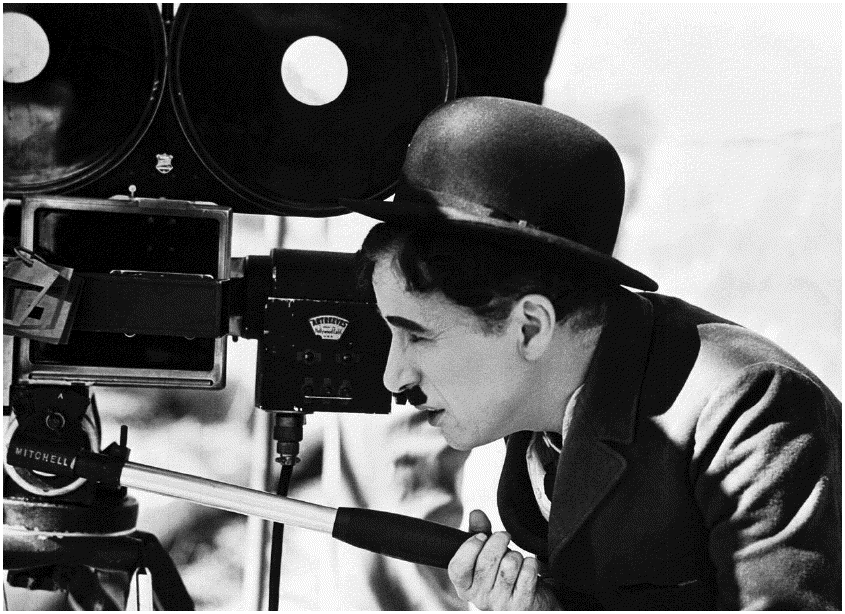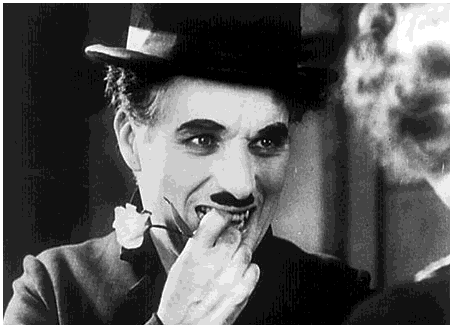
The Comedy of
Charlie Chaplin
Artistry in Motion
Dan Kamin
(Scarecrow Press)

Back in the 50s, when movie theatres were movie theatres, my wife and I would walk over to see movies at the Studio and Guild in Berkeley, California. These twin theatres were owned by Edward Landberg and his wife Pauline Kael, and were the original art movie houses: simple, small, no smell of melting butter or hot dogs. Only cappuccino.Kael's monthly mailings involved long critiques of the films to be shown in the coming weeks. Each theatre carried a double bill, with great films from Hollywood and around the world: Sergei Eisenstein, Jean Renoir, Orson Welles, Vsevolod Pudovkin, and, finally, Carl Dreyer. There was Dryer's Joan of Arc that I remember best, always in closeup, pulled this way and that by the questioning monks; and, finally, the auto da fé ... and the peasants in an old-fashioned medieval riot.
If you want to prop up a sagging marriage, I can't think of a better way than to spend whole evenings together watching great double features at a small exotic movie house.
§ § § I had been in love with Charlie Chaplin films long before, so one day I called up the theatre and ended up talking to Landberg --- those were the days --- and asked if he couldn't show City Lights or The Circus or Modern Times. He pointed out that not long before the American Legion had run Chaplin out of the country for his politics; the actor had shut down all rights to show his films here. However, said Landberg, they still had, somehow, one reel left over from City Lights, and if we dropped by the Guild that evening, they would be happy to run it between one of their two regular features. Those were the days.
So we did and they did (oh the fifties) and it was the famous fight scene from City Lights with Chaplin and Hank Mann which is, as Kamin notes, "one of the longest, funniest, and most elaborately choreographed scenes he ever devised." It is that good; indeed, so good that even if you are no Chaplin fan I urge you to rent or buy a CD of this movie if for no other reason than to watch the dance with Chaplin, Mann, and the referee ... presumably in a boxing match but really performing one of the greatest ballets in all of moviedom. I have probably seen this particular sequence thirty times, and it continues to tickle me ... and will, I believe, do the same for you.Kamin's book is jammed with facts and insights about Chaplin and his films. Harry Myers, the rich boozer in City Lights, turns blind when he is sober, doesn't "see" nor recognize the tramp. The flower girl, played by Virginia Cherrill, is blind, so she doesn't know until the very end that the man wooing her is a bum. In real life, Chaplin met Cherrill at a boxing match, and once said that she looked "blind as a bat" without her thick glasses. Thus she was, indeed, blind --- if only terribly near-sighted.
Kamin notes that for City Lights, Chaplin "reduced the size of his traditional mustache ... [and] lets some of the gray in his hair show through." Chaplin thus makes himself more vulnerable. In the drunk nightclub scene, though, he has exaggerated his makeup,
His eyebrows are large half-moons on his chalky-white face, giving his a clownish look.
"But the makeup is more subtle and naturalistic in the scenes with the blind girl."
Facial close-ups, so rare in Chaplin's films, lend the final moments a startling intimacy and power ... The final scenes are so skillfully set up and so beautifully acted that repeated viewings do not diminish their impact.
One of the posters in my college dorm room was the very last shot of the tramp, saying to the girl, "You can see now." He utters it with a winsome half-smile, eyes dark but seeing ... white flower in hand, finger in mouth, like a kid just found out.

For those of us who are insight junkies, Comedy is full of these artful twists. In one footnote, the author cites Julian Smith on the two most famous scenes in The Gold Rush: cooking work-boots for lunch; two dinner rolls in ballet on the table. Smith says, "At Thanksgiving, his shoe became food, now dinner rolls become little shoes." Kamin suggests that the vague machinery in the factory in Modern Times "shown in a cutaway" is like that of "a giant film projector." He concludes, "The factory is a film factory."Later scenes in Modern Times show a true albeit comic portrait of prison life, with gay prisoners and drugs. In the dining hall sequence where Chaplin imbibes "nose-powder," one of the other prisoners is "ludicrously effeminate, walking with his hands bent upward at the wrist and swiveling his hips and shoulders."
Because the viewer is riveted on Charlie revolving in his stoned state, this fellow invariably goes unnoticed in the several shots in which he appears.
§ § § When I saw my first Chaplin films, they were given added comic impetus by being speeded up. I had been told that newer projectors operated faster than the ones from the silent film era. But there are shooting logs for many of Chaplin's later films like Modern Times that reveal that he "shot much of it at eighteen frames per second, or 25 percent faster than life, and some of the chase and other action scenes at sixteen frames per second."
We also learn that the department store skating sequence (Chaplin is skating blindfolded, perilously near a ledge) was filmed using a "glass shot" and "trompe l'oeil paintings." Kamin cites no less than six authorities to kill the commonly held belief that Chaplin put himself in these dangerous shots and somehow never had a fatal nor disabling accident (vide, the famous monkeys-on-the-tightrope scene in The Circus.)
This is, I believe, a book that will be treasured by Chaplin fans, though some of the facts may be disturbing. We find, for instance, that there are many differently edited editions of each of his movies. While we may think we are watching the only one, there may be dozens of alternative takes floating around out there. "Like other major stars of the day, Chaplin shot every scene with two side-by-side cameras operating simultaneously."
Because of the great popularity of Chaplin's films, hundreds of prints had to be struck, so in some cases three or even four versions of the films were prepared, using the best alternate takes from each of the two cameras.
Even weirder are the alternative shots never used. Despite their intimacy on-screen, Virginia Cherrill was not very keen on Chaplin, either as a co-star nor as a pal. At one time they had a falling-out and Georgia Hale --- who starred in The Gold Rush --- was brought in as a possible replacement.
Hale's acting in the final scene (Former Blind Girl Sees the Truth) was so overwrought that, thankfully, Chaplin dropped her. Watching rushes of her made it apparent that Cherrill's art was dramatically understated, and we and the world of film are all that much richer because of her gentle and subtle acting technique.--- Richard Saturday